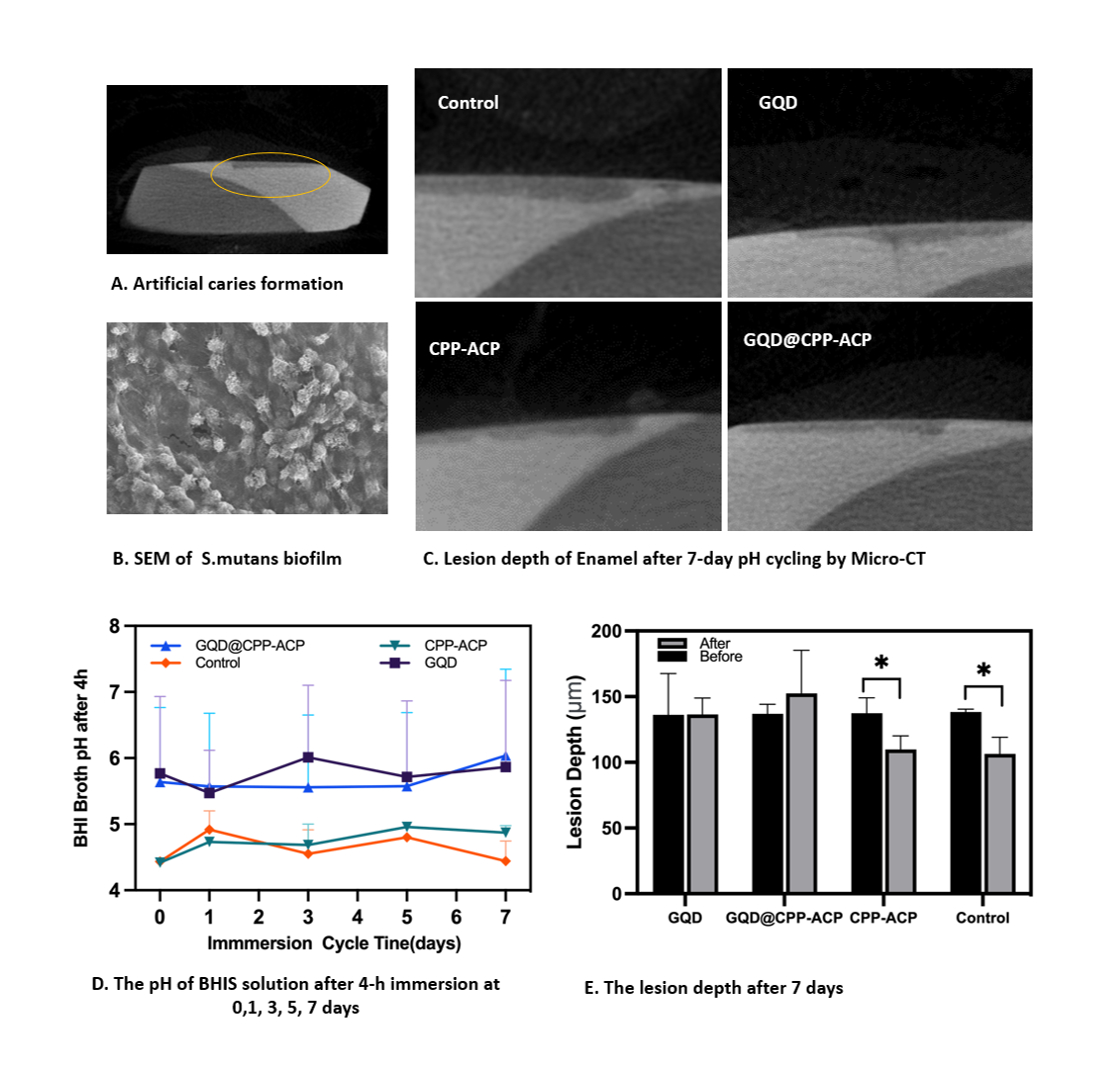IADR Abstract Archives
Effects of Graphene Quantum Dot on Antibiofilm and Remineralisation
Objectives: Graphene quantum dot (GQD) has merged as an effective alternative to traditional antibacterial agents. This study aimed to investigate the antibacterial and remineralising effects of the GQD combined with casein phosphopeptide-amorphous calcium phosphate (CPP-ACP) on enamel lesion in a biofilm-challenged environment.
Methods: The Minimum inhibitory concentration for Streptococcus mutans (S. mutans) of GQD was determined. S. mutans were grown on human enamel blocks. The antibacterial abilities such as growth kinetics were determined by Scanning Electron Microscopy (SEM), confocal laser scanning microscopy (CLSM), and culture colony-forming units (CFU). The remineralisation ability in a microbial environment was determined with the mineral loss, calcium-to-phosphorus ratio and surface morphology by SEM. To create a biofilm-challenged environment, enamel blocks were merged in S. mutans for 5 days to create the lesion, then went through pH cycling (4h in S. mutans and 20h in artificial saliva) for 7 days. The pH of brain heart infusion broth plus 2% sucrose (BHIS) solution was tested at 0,1, 3, 5,7 days, and the mineral changes were analysed by Micro-CT. Biocompatibility was tested using Cell Counting Kit-8 (CCK8) assay of Human gingival fibroblast (HGF-1).
Results: For remineralisation, CPP-ACP agent with GQD presented significantly more surface mineral regain compared to the control after 1 and 3 days by calcium-to-phosphorus molar ratios (P<0.05). Enamel covered by GQD showed better crystal structure formation than CPP-ACP alone. After coating on enamel surface, CPP-ACP agent with GQD inhibited S. mutans adhesion according to the lgCFUs of the control and GQD-treated groups (P<0.05). After 7-days pH cycling in a biofilm-challenged environment, CPP-ACP agent with GQD treated group showed higher pH value and less lesion depth than control group and CPP-ACP alone (P<0.05). The cytotoxicity of GQD showed no difference compared with control and CPP-ACP by CCK8 (P>0.05).
Conclusions: GQD could improve therapeutic and antibiofilm effects of CPP-ACP, and CPP-ACP agent with GQD could be a potential option for enamel lesion management.
Methods: The Minimum inhibitory concentration for Streptococcus mutans (S. mutans) of GQD was determined. S. mutans were grown on human enamel blocks. The antibacterial abilities such as growth kinetics were determined by Scanning Electron Microscopy (SEM), confocal laser scanning microscopy (CLSM), and culture colony-forming units (CFU). The remineralisation ability in a microbial environment was determined with the mineral loss, calcium-to-phosphorus ratio and surface morphology by SEM. To create a biofilm-challenged environment, enamel blocks were merged in S. mutans for 5 days to create the lesion, then went through pH cycling (4h in S. mutans and 20h in artificial saliva) for 7 days. The pH of brain heart infusion broth plus 2% sucrose (BHIS) solution was tested at 0,1, 3, 5,7 days, and the mineral changes were analysed by Micro-CT. Biocompatibility was tested using Cell Counting Kit-8 (CCK8) assay of Human gingival fibroblast (HGF-1).
Results: For remineralisation, CPP-ACP agent with GQD presented significantly more surface mineral regain compared to the control after 1 and 3 days by calcium-to-phosphorus molar ratios (P<0.05). Enamel covered by GQD showed better crystal structure formation than CPP-ACP alone. After coating on enamel surface, CPP-ACP agent with GQD inhibited S. mutans adhesion according to the lgCFUs of the control and GQD-treated groups (P<0.05). After 7-days pH cycling in a biofilm-challenged environment, CPP-ACP agent with GQD treated group showed higher pH value and less lesion depth than control group and CPP-ACP alone (P<0.05). The cytotoxicity of GQD showed no difference compared with control and CPP-ACP by CCK8 (P>0.05).
Conclusions: GQD could improve therapeutic and antibiofilm effects of CPP-ACP, and CPP-ACP agent with GQD could be a potential option for enamel lesion management.



